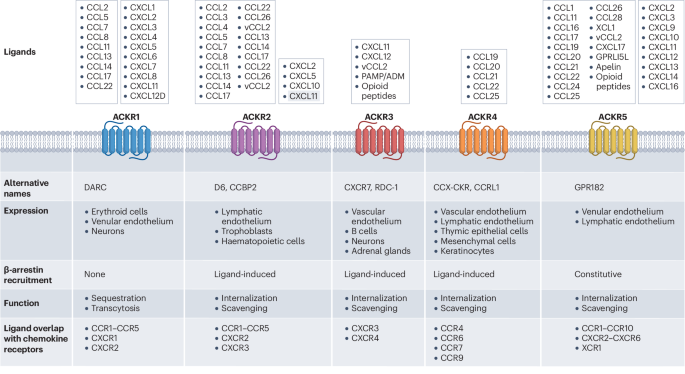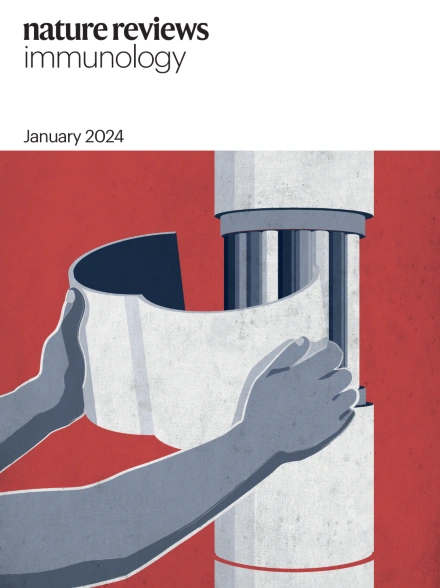Inclusion of ACKR5 in the systematic nomenclature of atypical chemokine receptors
IF 60.9
1区 医学
Q1 IMMUNOLOGY
引用次数: 0


在非典型趋化因子受体的系统命名中包含ACKR5
Comerford和McColl1最近在该杂志上发表的一篇综述讨论了非典型趋化因子受体(ACKRs)如何在免疫系统内外成为趋化因子的重要调节因子。与传统的趋化因子受体不同,ackr不与G蛋白偶联,因此不会在趋化因子的作用下诱导细胞迁移。相反,ackr通过配体的隔离、运输、内化和降解递送来调节趋化因子在特定组织微环境中的可用性。今年是国际基础与临床药理学联合会(IUPHAR)命名委员会对ackr进行系统分类的十周年。直到最近,这个亚家族包括四个受体(ACKR1-ACKR4),但正如本文所讨论的,其他分子正在被研究作为ACKR家族的潜在新成员。2024年10月,其中一个分子GPR182被IUPHAR正式确认为ACKR5(参考文献3)(图1)。1: ACKR配体的选择性、表达、功能及与经典趋化因子受体的串扰。非典型趋化因子受体(ACKRs)在不同类型的内皮细胞或免疫细胞上表达。ACKR1和ACKR2结合广泛的炎性趋化因子,它们与CXCR1-CXCR3和CCR1-CCR5共享。ACKR3结合与CXCR4共享的稳态趋化因子CXCL12,以及与CXCR3共享的炎性因子CXCL11。ACKR4与CCR4、CCR6、CCR7和CCR9共享的有限数量的主要稳态趋化因子相互作用。ACKR5结合与CCR1-CCR10、CXCR2-6和XCR1共有的广泛的XC、CC和CXC趋化因子。ACKR3和ACKR5也结合非趋化因子配体。对于CXCL11,它被描绘在ACKR2上方的灰色框中,因为它是拮抗剂。全尺寸图像
本文章由计算机程序翻译,如有差异,请以英文原文为准。
求助全文
约1分钟内获得全文
求助全文
来源期刊

Nature Reviews Immunology
医学-免疫学
CiteScore
93.40
自引率
0.40%
发文量
131
审稿时长
6-12 weeks
期刊介绍:
Nature Reviews Immunology is a journal that provides comprehensive coverage of all areas of immunology, including fundamental mechanisms and applied aspects. It has two international standard serial numbers (ISSN): 1474-1733 for print and 1474-1741 for online. In addition to review articles, the journal also features recent developments and new primary papers in the field, as well as reflections on influential people, papers, and events in the development of immunology. The subjects covered by Nature Reviews Immunology include allergy and asthma, autoimmunity, antigen processing and presentation, apoptosis and cell death, chemokines and chemokine receptors, cytokines and cytokine receptors, development and function of cells of the immune system, haematopoiesis, infection and immunity, immunotherapy, innate immunity, mucosal immunology and the microbiota, regulation of the immune response, signalling in the immune system, transplantation, tumour immunology and immunotherapy, and vaccine development.
 求助内容:
求助内容: 应助结果提醒方式:
应助结果提醒方式:


